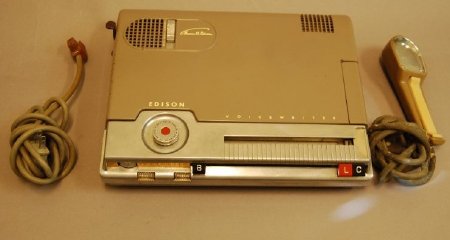Object ID:
2013.9abc
Title:
Edison Voice Writer, Model 76500
Creator:
Thomas Edison Company
Description:
(a) Gray-brown enameled cast aluminum chassis, rectangular with rounded edges; bright aluminum trim on front of console; grillwork in upper left and upper right; jacks for microphone, power cord, and remote control on back edge; bright aluminum slider-type power switch in upper left; slot in right side of chassis accepts recording disks, a small hinged hatch there makes removal easier; three sliding toggles on front labeled "B", "L" and "C"; the L and C toggles are connected to a pricker that marks a paper recording tape (not present with unit); the cardstock tape fits into a horizontal slot above the toggles and allows the user to record corrections ("C") and length ("L") marks onto the tape; a bright aluminum dial on the front left--marked with a red dot--is pulled out to play back a recorded disc, and pushed in to place the unit in record mode; the dial can be rotated left or right to move the internal recording head across the disk being recorded to the desired position; two clear plastic lights on left front, the left most indicates power on, and the right illuminates when the disk is playing or recording; a thin, perforated piece of gold-tone trim is mounted above the lights; four plastic feet on base; plastic coated steel microphone bracket on left side; foil label on base reads, "Edison/MODEL 76500/SERIAL NO. D720147/EDIPHONE DIV., WEST ORANGE, N.J." (b) microphone; (c) power cord.
Dimensions:
H-2.625 W-12.25 D-9.5 inches
Date:
ca. 1952
Place of Origin:
West Orange, NJ
Provenance:
Found in storerooms at the Delaware County Workers for the Blind in Muncie, IN. The case was designed for Edison by Carl Otto and introduced by 1954. Office dictation equipment was used by professional stenographers who were blind or visually impaired to type documents for others, and also by blind professionals to record letters, notes, or any other material they wished to archive. Disc-cutting systems such as the Voice Writer, Sound Scriber, and Dictaphone began to decline in popularity in the 1960s, replaced by tape based systems.
Credit Line:
Gift of Delaware County Workers for the Blind, 2013.9.
